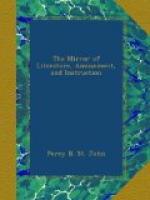In the church are some monumental brasses and a handsome tomb of marble and alabaster. One of the former is to the memory of Nicholas Ansley, or Annesley, Esq. who died in 1593; with the following inscription:—
When the Quene Elizabeth full five years
had rain’d,
Then Nicholas Ansley, whos corps lyes
here interred,
At fyve and twenty yeres of age was entertayned
Into her servis, where well himself he
caried
In eche man’s love till fifty and
eight yeres ould,
Being Sergant of the Seller, death him
contrould.
Above is an upright figure (on a brass plate,) of the deceased, in armour, kneeling at a desk. The latter monument is to Brian Annesley, Esq. (son of Nicholas) gentleman pensioner to Queen Elizabeth. It consists of an elliptic arch supported by Corinthian columns, and ornamented with a Mosaic pattern studded with roses. Beneath lie the effigies of Annesley, in armour, and his wife, in a gown and ruff; their son, and three daughters.
In the churchyard, among the tombs, is that of Dr. Halley, who succeeded Flamstead as Astronomer Royal at Greenwich, where he died in 1741-2: Halley published a treatise on Comets, when he was nineteen years old; and first applied the barometer to measure heights. Here also lie William Pate, whom Swift, in his Letters, calls the learned woollen-draper: Sir Samuel Fludyer, bart., the courtly lord mayor; Parsons, the comedian, with this quaint epitaph:—
Here Parsons lies, oft on life’s
busy stage
With nature, reader, hast
thou seen him vie;
He science knew, knew manners, knew the
age,
Respected knew to live, lamented
die.
Bliss, the Astronomer Royal, who died in 1762, is also buried here; Charnock, the author of Biographia Navalis, a Life of Nelson, &c.; the amiable Lord Dacre, who died in 1794; and Mary, his relict, 1808.[5]
[5] Lady Dacre visited her dear lord’s tomb daily for several years; at the foot of the grave she was accustomed to kneel, and utter a fervent prayer. We can just remember seeing this devout lady on one of these pilgrimages. She usually rode from her mansion in the neighbourhood to the churchyard, on a favourite poney, and wore a large, flapping, drab beaver hat, and a woollen habit, nearly trailing on the ground. At home she evinced an eccentric affection for her deceased lord: his chair was placed, as during his lifetime, at the dinner-table; and its vacancy seemed to feed his lady’s melancholy.
Harris says that Samuel Purchas resided at Lee, and there wrote a great part of his collection of travels, or “Celebrated Pilgrimages and Relations of the World.”
Among the grateful recollection of Lee we must not omit the alms-house, chapel, and school-house founded by C. Boone, Esq. in 1638.
* * * * *




